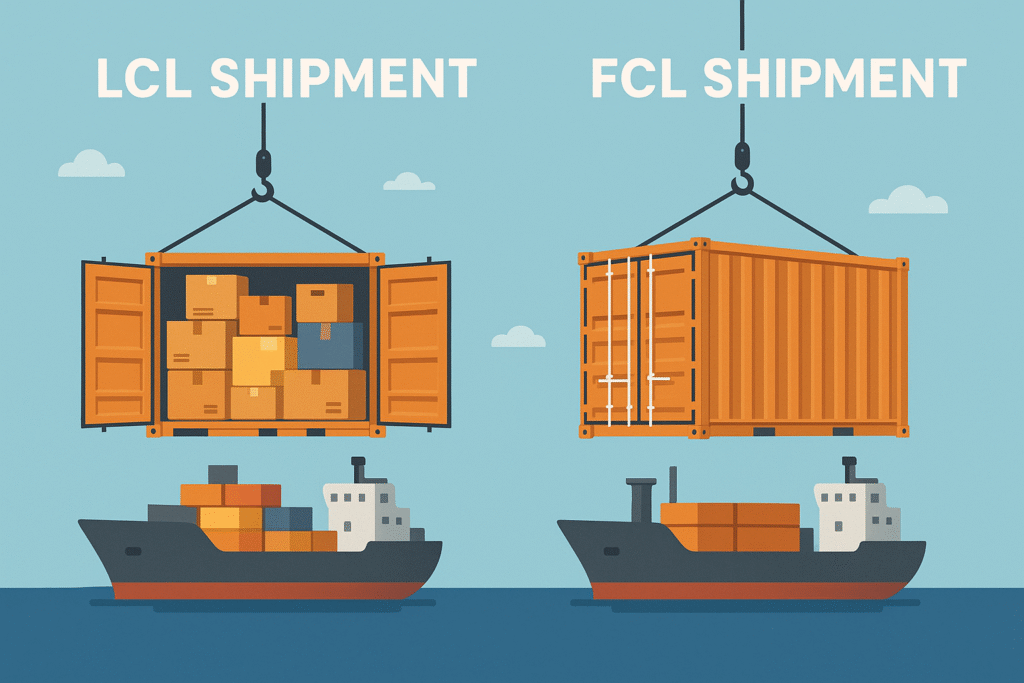A Practical Guide for Exporters and Importers
In international trade, choosing the right shipping method is crucial for cost efficiency, timely delivery, and overall supply chain performance. Two common modes of ocean freight are LCL (Less than Container Load) and FCL (Full Container Load). Each has its own advantages and limitations depending on your cargo size, budget, and business goals.
Let’s dive into the pros and cons of LCL and FCL shipments to help you make an informed decision.
What is LCL (Less than Container Load)?
LCL is when your cargo does not fill an entire container and is shipped along with goods from other exporters/importers. You pay for only the space your cargo occupies.
Pros of LCL Shipments
- Cost-Effective for Small Shipments
You pay only for the volume used, making it ideal for businesses with limited cargo. - Lower Inventory Holding
Enables just-in-time inventory strategies, reducing storage costs. - Frequent Departures
Consolidators often offer weekly schedules, giving flexibility to smaller exporters. - Ideal for Testing New Markets
Great for trial shipments or entering a new international market without full container investment.
Cons of LCL Shipments
- Longer Transit Time
Time is added for consolidation at origin and deconsolidation at destination. - Higher Handling Risks
More frequent handling increases the chances of cargo damage or loss. - Hidden or Additional Costs
Charges like documentation, handling, or delivery fees may increase overall cost. - Limited Control
You’re dependent on the consolidator’s schedule, packaging, and service quality.
What is FCL (Full Container Load)?
FCL means booking the entire container for your shipment, regardless of whether you use all the space.
Pros of FCL Shipments
- Faster Transit and Handling
No need for consolidation; container moves directly from shipper to consignee. - Reduced Risk of Damage
Less handling and no mixing with other cargo reduce breakage, theft, or contamination. - Economies of Scale
For larger volumes, the per-unit cost is lower compared to LCL. - More Control Over Loading & Packing
You can optimize packaging, labeling, and cargo arrangement to your preferences.
Cons of FCL Shipments
- Higher Initial Cost
You pay for the full container even if it’s partially filled. - Larger Inventory Requirements
Ties up more capital in inventory and may require more storage space at destination. - Less Flexibility for Smaller Businesses
May not be feasible for companies with limited volume or capital.
When to Choose LCL vs FCL?
| Scenario | Recommended Option |
|---|---|
| Cargo volume < 12 CBM | LCL |
| Cargo volume > 15 CBM | FCL |
| Urgent and high-value cargo | FCL |
| Testing new market or product | LCL |
| Need for secure, sealed shipment | FCL |
| Budget constraints | LCL |
Conclusion
Both LCL and FCL offer strategic value in global logistics. The right choice depends on the size, urgency, sensitivity, and frequency of your shipments. For businesses scaling up, LCL is a good stepping stone, while FCL offers better cost efficiency and security for high-volume exports.
Understanding these options ensures smarter logistics planning, better customer service, and optimized supply chain operations.
Need Help Choosing the Right Shipment Mode?
At EximTutor, we guide exporters and importers in making cost-effective logistics decisions. Reach out for personalized consultancy on your next shipment!

